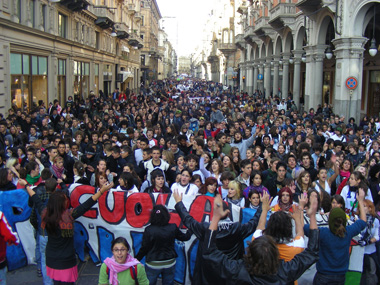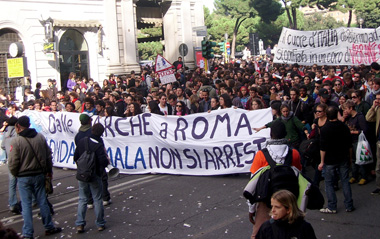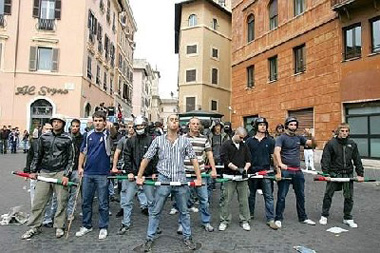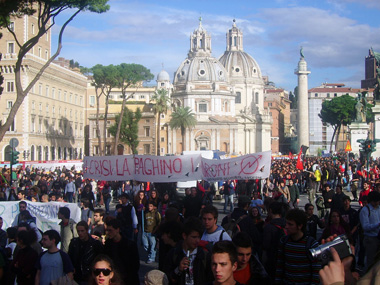We reported in a previous article on the development of mass movements confronting the Berlusconi government in Italy. In the last few weeks the struggles have gained further momentum, in what appears to be a handbook example of the unfolding of class struggle. As usual, the youth, that sensitive barometer of society, moves first. Then it spreads its contagion to those sectors of workers who are closer to them, such as schoolteachers, researchers, etc., and often their own family members. Then the rest of the working class quickly gains confidence, while the more left-wing trade union leaders sense the need to start acting in a bolder way. Strikes start to be called and in a situation like the one in Italy, they easily become general strikes. In just a few months, the whole country is in turmoil.
The Wave arises
"The Wave" (l'Onda) has become the official name of the students' movement against the programme of cuts and privatisation presented by Berlusconi and his ministers Tremonti and Gelmini. It started almost simultaneously in most schools and universities of the country once the content of these reactionary measures was announced by the government.
 |
| Demonstation in Turin, October 30th, 2008. |
On October 30th a national strike of the school staff was called and on November 14th it was the turn of university personnel. As we could easily predict, both strikes were a huge success and connected with the students' mobilisations, becoming part of the Wave and pushing other layers of workers and youth into action.
On October 30th, a national demonstration of school and university students in support of the strike was organised in Rome. The organisers said that one million people participated in the demonstration; other sources give lower figures, but always in the order of hundreds of thousands. However, these huge figures only refer to the marches in the country's capital. There were dozens of local mobilisations where teachers, pupils, researchers, non-academic workers and schoolchildren's parents joined together in massive demonstrations on city or province level. In many minor cities, October 30th saw the largest demonstration for ten, twenty or even thirty years.
On the basis of the experience of recent years, when intense but short outbursts of student anger would occasionally occur almost every autumn, some feared that this demonstration could represent the climax of the movement, after which things would rapidly start to calm down and die out. This was probably also the hope of Berlusconi, who stubbornly insisted on his line that the students were "misled by propaganda" and left-wing teachers just wanted to defend their alleged privileges. On the contrary, October 30th represented in many cases an opportunity to close ranks and launch new forms of organisation of the movement. The national university strike on November 14th, supported by a 200,000-strong march in Rome, provided the opportunity for a first nationwide gathering of the university movement.
The Wave has reached a size where quantity turns into quality: the students are starting to organise discussion groups, workshops to analyse the attack and to propose an alternative reform of education and research, and in some cases also general meetings on a faculty, university or school level to elect delegates to represent in a democratic manner the demands and opinions of those who partake in the struggle. This means that even when the movement does finally recede it will not return to what we had before. A layer of politically aware students and workers will continue to organise, discuss and prepare for the future.
How can the students win?
The occupied faculties of La Sapienza University in Rome, one of the epicentres of the protest, hosted a two-day meeting that produced a series of documents that demonstrate the political awareness of some wings of the movement. Several demands were extremely advanced and had an anti-capitalist content.
 |
| Demonstration in Rome, November 14th, 2008. |
At the same time, there are also confused formulations in these documents and in general the whole process by which these provisional manifestos were produced was quite chaotic. This is the result of the influence of petit bourgeois or semi-anarchistic tendencies within some wings of the movement - often the same groups who had a role in misleading a part of the Italian anti-globalisation movement in 2001-2003. These fringe groups are making a serious mistake if they think they can impose their slogans and terminology on a mass movement without a thorough and fully democratic discussion organised with delegates elected from below and immediately recallable, clear demands and a strong connection with the workers' movement. They only risk splitting the movement or separating it from the workers for the sake of having their own favourite wording used in the leaflets and documents. The most moderate wing of the movement, influenced by the bourgeois Democratic Party, is probably just waiting for an excuse to create such a split and try to set the movement on a more "reasonable" path.
Nonetheless, the large attendance at the Rome meeting demonstrates the need for a national action committee that can legitimately act as a co-ordinating body, make proposals, raise demands, and eventually enter into negotiations with the government. In a democratic process, different ideas, trends and organisations would be put to the test. This is how it works in France or Spain and what made those movements so strong in the past, e.g. in the struggle of the French youth against the CPE in 2006. In Spain, these traditions are expressed through the established position of the Marxist-led Students' Union (Sindicato de Estudiantes) in the schools. Precisely because we are very confident of the potential of this movement, we trust in its collective wisdom and its ability to select the best spokespersons in order to create links with the workers' movement and conduct serious and uncompromising negotiations with the government, turning a defensive struggle into a struggle to force the government to grant more funding to state education and research and reverse its disgraceful "reforms".
Stop us if you can!
If some crucial conditions are met, reversing the trend of cuts and privatisations is entirely possible. We have to bear in mind that this trend has at least a continental, if not a worldwide, character. The so-called "Bologna process" (an international agreement launched in 1999 to harmonise the European education systems according to the criteria of privatisation and competition) is provoking protests in Spain, Greece, France, Germany and other countries. The attacks by individual national governments are part of this supranational offensive of the ruling classes of Europe. It is entirely possible that in the following weeks or months we will see an all-European mobilisation of the youth. If a European upheaval of the students starts, also those countries, like Britain or Sweden, that have not yet been affected by the movement could be immediately involved.
The first few weeks of mobilisations in Italy have been enough to compel minister Gelmini to introduce some modifications into her proposed changes to the university system. The turnover rates for the university personnel have been relaxed, thus allowing the hiring of a few more young professors and researchers. In a clear attempt to divide the movement, the cuts have been temporarily suspended for the so-called "virtuous universities", i.e. the ones who already spend less than others or collect higher fees from their students - usually the ones from the most developed parts of the country or that are more closely connected to private sponsors. Further funding has been given to support scholarships, enabling for the first time all the Italian students who had a right to receive financial aid to actually receive some, which is obviously good news for them, although in actual fact this is only what they were already entitled to anyway! However, in spite of these small concessions, most of this reactionary agenda is still in place and the protestors clearly did not fall for this clumsy attempt to divide and divert the movement. In actual fact these first small concessions can have the opposite effect to that which the government desired. They give the signal that protesting pays!
A whole spectrum of shameful manoeuvres has been tried by the Right with the purpose of diverting, confusing and in the last analysis destroying the movement. Right-wing and militant Catholic youth groups have tried to organise a counter-mobilisation in favour of the cuts. Since in some cases classes have been interrupted by the protests, they have tried to organise protests of "good students" in defence of the "right to study" without being disturbed by the protestors. Apparently, for these people the long-term destruction of the education system is not going to disturb the right to study!
Groups like Communion and Liberation (Roman Catholic pro-capitalist fundamentalists) and Forza Italia Youth (the phantom youth section of Berlusconi's party) have collected signatures, given out leaflets, and even organised some tiny demonstrations in a few places. In some cases, feeling the support of the national government behind them, they have resorted to hooligan actions. The day before the big university strike, the youth group of the ex-Fascist party, Azione Giovani went to the point of occupying two offices of the main trade union confederation, CGIL, as a protest against the strikes. This was correctly denounced by the union leadership as a Blackshirt-like aggression. All these initiatives were met with indifference or open hostility by the majority of students, and resulted in complete failure.
 |
| Fascist provocations in piazza Navona, Rome, October 29th, 2008. |
Some more radical and violent far-right groups (like the Students' Bloc organised by an openly Fascist party) have used different tactics. They have been trying to infiltrate the movement "supporting" some of its demands and taking advantage of the "anti-political" mood that prevailed in the movement during its first weeks of existence. On October 29th (once again, the day before a national strike!), in Rome, violent clashes erupted between left-wing students and Fascists. The Fascists had clearly prepared a provocation (some say in agreement with the police) coming to the demonstration with a lorry loaded with sticks and other weapons.
In many cases, state violence was directly used to repress the demonstrators. Occupied schools have been cleared by the police, students (also minors) have been victimised, peaceful demonstrations charged. The aim is to weaken the movement by separating the politically aware advanced layers from the bulk of students and workers, scaring the average demonstrator away from the marches and turning them into sterile clashes with the police, then using this for reactionary propaganda in the mass media, as was actually suggested by the ex-President of the Republic Francesco Cossiga. We can say that these attempts have completely failed. Some hypocritically "friendly" statements by minister Gelmini have not had any effect (at a certain point, demagogically of course, she even dared say that she actually agreed with what the students were saying...). Everybody understood that it was just part of the same old manoeuvres.
Also the Democratic Party, the main party of the parliamentary bourgeois opposition to Berlusconi, is becoming increasingly worried about the development of political awareness within the movement. In an attempt to divert the movement and give it a "practical goal" in the future, thus encouraging normalisation and the end of the protests, the Democrats have proposed the calling of a referendum to abolish the measures proposed by the government and recently approved by parliament. The proposal to hold a referendum is a trap. Besides being largely unfeasible (part of the measures are contained in a three-year budget that cannot simply be scrapped), it would be political madness to delay everything until a referendum which would most likely be held in 2010. It would mean demobilising and wasting the energies of the huge movement that is presently going on. It is a tactical diversion on the part of the Democrat leadership to push the Wave out of the spotlight and replace it with an inconsistent and ineffective parliamentary opposition.
The working class steps in
On October 17th, a coalition of minor left-wing trade unions organised a general strike. This strike did not paralyse the country, because the main organisations were not involved, but it did show that some advanced layers of workers were prepared to fight back.
The FIOM (the metalworkers' section of the CGIL confederation, but more left-wing) is the largest metalworkers' union in Italy, with more than 350,000 members, including not only blue-collar, but also white-collar workers and workers of other industries that belong to the same national bargaining agreement, and it represents a traditional key layer of the class. On October 31st, the day after the first national joint mobilisation of workers and students, 5000 FIOM shop stewards met in a national assembly that decided to call for a national strike on December 12th.
The leadership of FIOM has explained the link between the economic crisis and the attacks on the students and on workers' rights. The platform worked out for the strike is along the following lines. It opposes cuts and privatisations in the education system as well as in healthcare and pensions. It calls for social protection for the unemployed. It demands that immigrant workers who lose their jobs because of the economic crisis should not be considered illegal immigrants as is currently the case. It calls for a revision of taxation so that financial profiteers are hit harder and extra tax due to the fiscal drag mechanism is given back to the workers. These proposals were met with enthusiasm by the shop stewards, representing the militant backbone of the Italian proletariat.
With the teachers and metal workers in turmoil, public servants and transport workers on a war path with the government, the students' movement exposing the lack of consensus for the clique around Berlusconi among large layers of the youth, and the beginning of a recession... a little bit of bullying and a few provocations on the part of the government and the bosses was all that was missing to set in motion the whole CGIL confederation (totalling 5,600,000 members).
 |
| Guglielmo Epifani, CGIL leader. |
The straw that broke the camel's back was an "informal meeting" that took place in November at Berlusconi's residence in Rome (a luxurious 16th-century palace). Berlusconi's guests were a few ministers, the leader of the Confindustria bosses' association, the leader of the Christian trade union CISL (4,400,000 members) and the leader of the ex-Socialist trade union UIL (2,000,000 members). Guglielmo Epifani, the leader of the CGIL was not invited, a clear signal that the leader of the most left-wing union is not welcome at these meetings. Berlusconi, in an attempt to confuse the issues, claimed in a TV show that the meeting had been organised without him knowing about it, and he was notified just a few minutes in advance, which is hard to believe considering that it was in his own home!
Berlusconi's line on industrial relations has always been one of excluding the "unreliable" CGIL confederation from so-called "negotiations", which are in fact simply dirty deals behind the backs of the workers. Several such deals have already been signed on different issues, with the three main trade unions splitting several times between "hard-liners" (usually, the CGIL and some minor organisations) and the "negotiators".
However, the position of Epifani has never been completely consistent. Now he is being pushed into action and a general strike has been called for December 12th. The platform on which it has been called is not as radical as that of the FIOM, but it still calls for financial aid to wage workers and retired citizens to face the crisis, measures against unemployment and redundancies, an extraordinary plan of state investments in Southern Italy, and the reversal of cuts in public services, education, etc. The CGIL leadership is also sending the government a warning that it is not possible to simply ignore them.
The class struggle is our element!
The Marxist tendency that publishes FalceMartello and is part of Rifondazione Comunista has called for a special effort on the part of the party to turn this general strike into a real opportunity for mobilisation from below. To achieve this aim, it is necessary to connect the mobilisation with the daily struggles in each workplace where the Communists are present and active. A plan of party activities within the workplaces has been worked out, and the Marxist tendency is playing a leading role in this work.
 |
| Demonstration in Rome, November 14th, 2008. |
This is the best way to make Rifondazione's new course become real. The new course is supposed to be more left-wing but in several cases this is simply not happening. We can quote the examples of Milan, Bologna or the Abbruzzo region where the old nonsense of local alliances with the Center-Left (now the Democratic Party) is being repeated again and again, not just by the right wing of the party but by also supposed supporters of the "turn to the left".
This is especially a problem in a moment when the right wing of Rifondazione, the bureaucratic clique around Nichi Vendola, Fausto Bertinotti and others, is openly organising a split. They even dared to ask for an extraordinary party congress because "the students' movement began and Obama won the elections", something that they claim has "changed everything". In their opinion, since some of the students in struggle are still very critical towards organised party politics (the basic reason being the terrible performance of the Left while in the government with Prodi), the Italian Left should dissolve itself into a new Social Democrat Party that should take an inspiration from... the policies of the American Democrats!
There will of course be no emergency party congress, because the last one took place only a few months ago - and it is also ironic that such a request comes from those bureaucrats who always delayed congresses for years when they were in control of the party apparatus! Nevertheless, this shows the level of provocation and aggressiveness of this reformist faction. It is therefore even more important for the left wing of Rifondazione to organise more in order to counter this rightward pressure coming from both Vendola's liquidators and also ambiguous and bureaucratic tendencies within the new party majority. For this reason, the comrades who in the last congress defended the fourth document (based on the positions of the Marxist tendency that coincide with the line of Marxist.com) have organised a two-day national assembly in Rome: With the students and the workers, For the turn to the left! This meeting will take place just a few days before the general strike. It will show once more the importance of the role of the Marxists in what we consider our natural element: the class struggle!
See also:
- Italian workers and students are fighting back: “We won’t pay for your crisis!” by Mauro Vanetti and Fernando D’Alessandro (October 27, 2008)
- Italy: Rifondazione Comunista turns left – Interview with Claudio Bellotti by In Defence of Marxism (August 29, 2008)
- Italy: Conference of FalceMartello – on the verge of a new leap forward by Fred Weston (May 7, 2008)
- Italy: Berlusconi’s victory will prepare a massive workers’ backlash by Fernando D’Alessandro (April 15, 2008)
- The decline and fall of Romano Prodi exposes the rottenness of Italian capitalism by Mauro Vanetti (February 1, 2008)